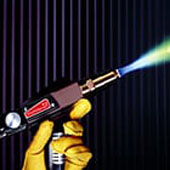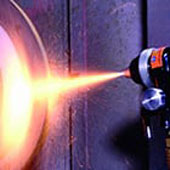
 For machine parts requiring high hardness in addition to corrosion and wear resistance, our gas-fueled HVOF process is the ideal solution. It produces coatings that are hard, thick, dense, and have fine, homogeneous structures.
For machine parts requiring high hardness in addition to corrosion and wear resistance, our gas-fueled HVOF process is the ideal solution. It produces coatings that are hard, thick, dense, and have fine, homogeneous structures.
Process description
Depending upon your requirements, propylene, propane, hydrogen, or natural gas may be used as the fuel in our High Velocity Oxygen (gas) Fuel (HVOF) thermal spray systems. As a result of the high kinetic energy transferred to the particles through both HVOF processes, the coating material generally does not need to be fully melted. Instead, the powder particles are in a molten state and flatten plastically as they impact the workpiece surface. The resulting coating has a very predictable chemistry that is homogeneous and has a fine granular structure.

| Heat source | Fuel (gas) and Oxygen |
| Material | Powder (Metal) |
| Arc temperature | Approx. 2,800 °C |
| Particle velocity | 400 – 800 m/s |
| Spray performance | 40 – 150 g/min |
Key characteristics
| Produces coatings that are very clean, hard, and dense with fine, homogeneous structures |
| Coatings are tenaciously bonded to the substrate |
| Has low compressive stress, which results in very thick coatings |
Typical applications
| Landing gear |
| Calender rolls |
| Kaplan blades |




